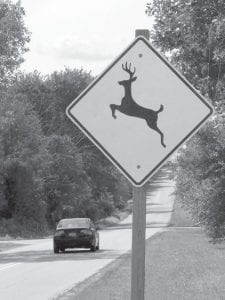You’re driving home from work when you sense movement in the ditch next to the highway; you pump your brakes in time to avoid the two eyes now flashing in the darkness that have moved onto the roadway. You sigh in relief as the deer scampers off into the darkness.
The Minnesota Department of Transportation reports Minnesota averages about 35,000 deercar collisions a year, and three to 11 fatalities. So, what can you do to stay safe when Minnesota’s deer season gets under way? Dawn and dusk are the times you are most likely to encounter deer along the roadside. Deer-breeding season runs from October through early January, and during this time, they are highly active and on the move. This is when deer-vehicle collisions are at their peak.
Although deer may wander into neighborhoods, they are more frequently found on the outskirts of town and in heavily wooded areas. As pack animals, deer almost never travel alone. If you see one deer, you can bet there are others nearby.
If you are driving through an area known for high deer populations, slow down and observe the speed limit. The more conservative you are with your speed, the more time you will have to brake if an animal darts into your path. Always wear a seatbelt. The most severe injuries in deer-vehicle collisions usually result from failure to use a seatbelt.
Use your high beams whenever the road is free of oncoming traffic. This will increase your visibility and give you more time to react. Deer can become mesmerized by steady, bright lights, so if you see one frozen on the road, slow down and flash your lights. NHTSA and other experts recommend one long blast of the horn to scare them out of the road as well.
Never swerve to avoid a deer in the road. Swerving can confuse the deer on where to run. Swerving also can cause a head-on collision with oncoming vehicles, take you off the roadway into a tree or a ditch and greatly increase the chances of serious injuries.
Don’t rely on hood whistles or other devices designed to scare off deer. These have not been proven to work.
If you do collide with a deer or large animal, call emergency services if injuries are involved or local police if damage has been caused to your property or someone else’s. Never touch an animal in the roadway.



Loading Comments